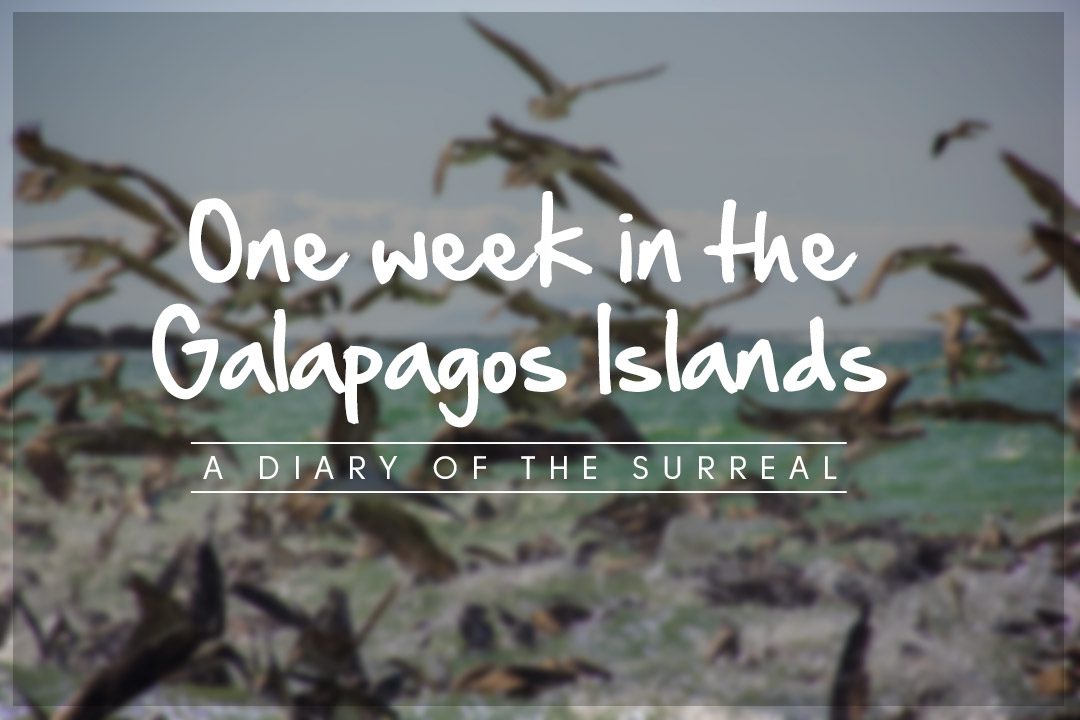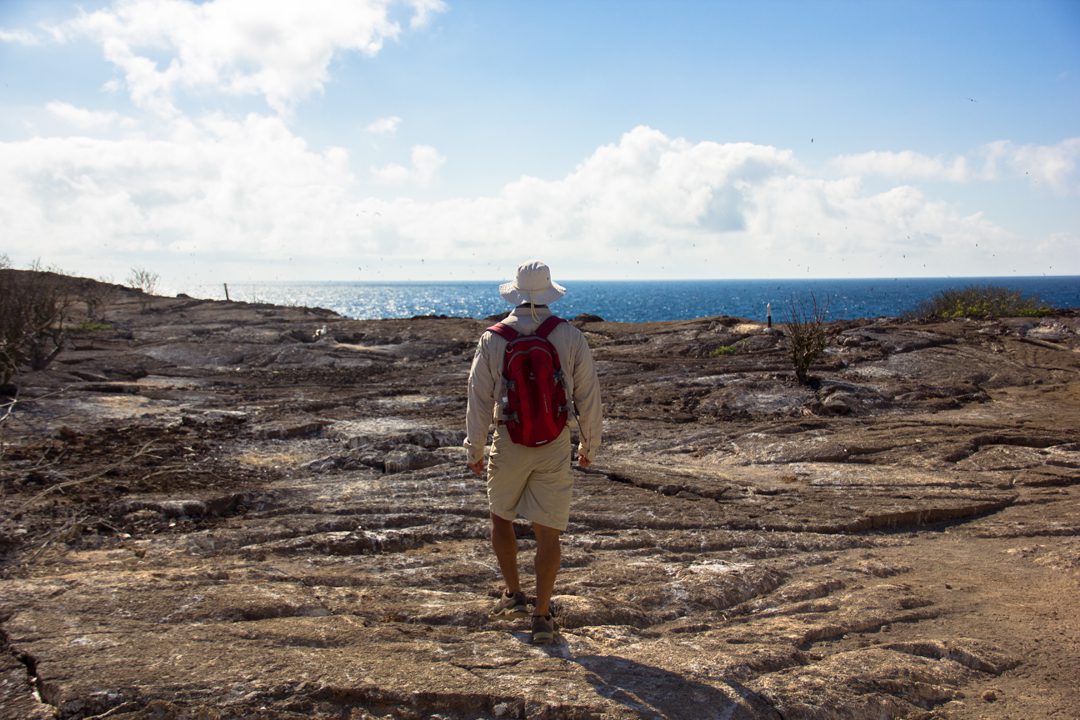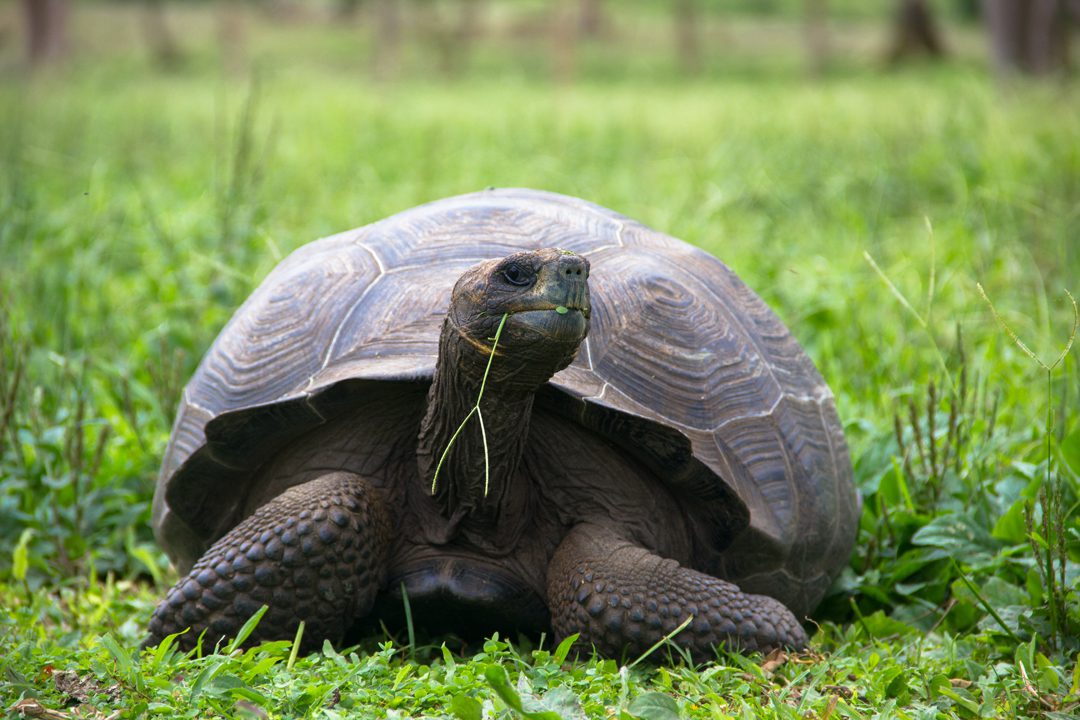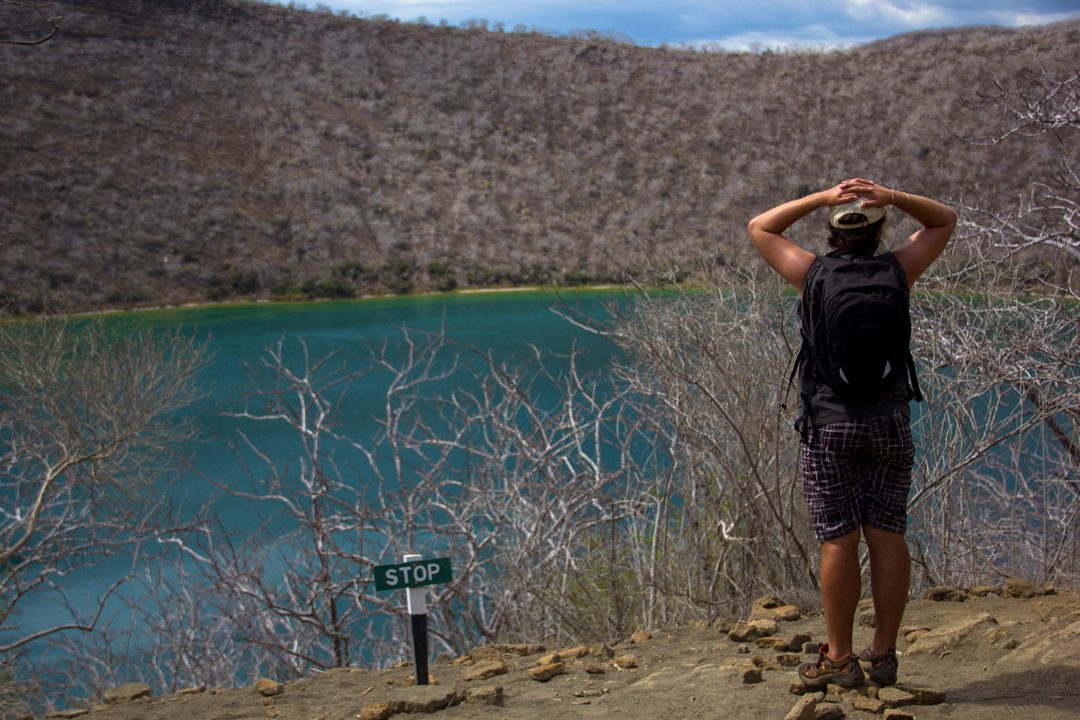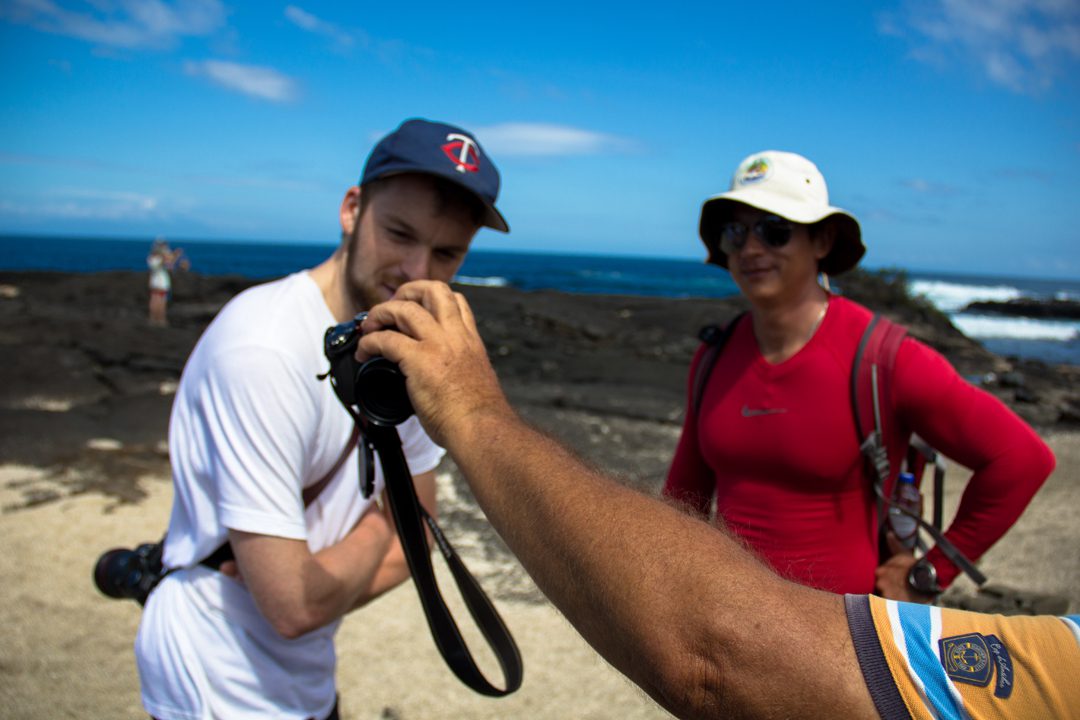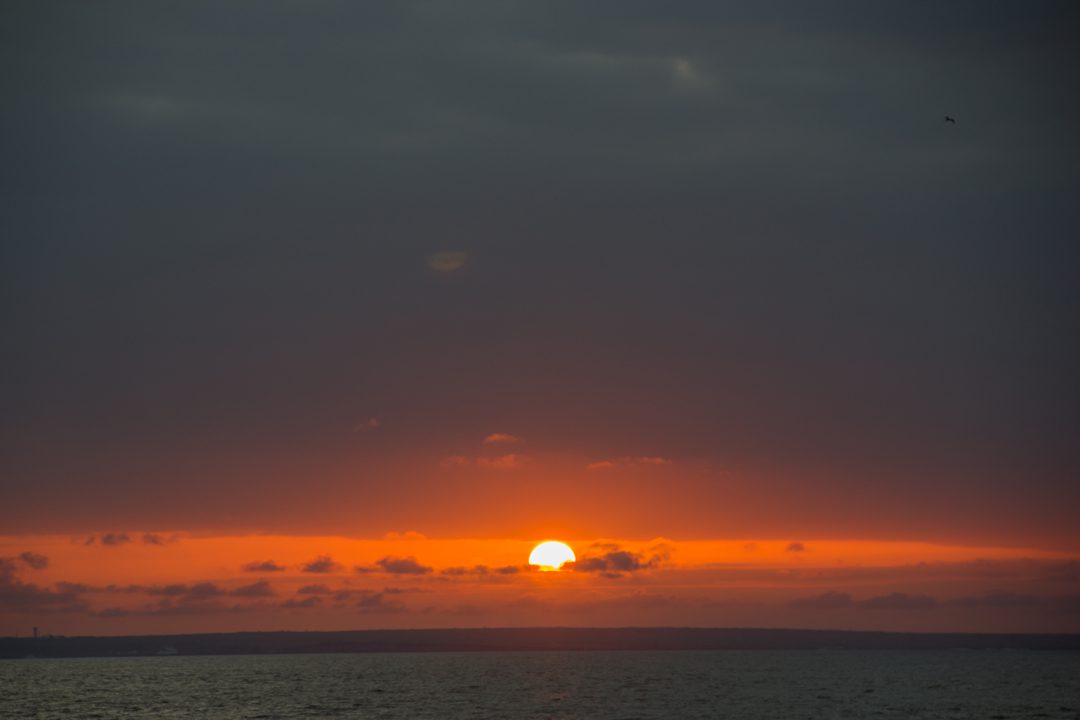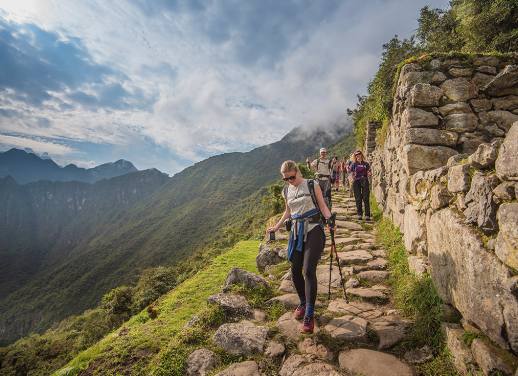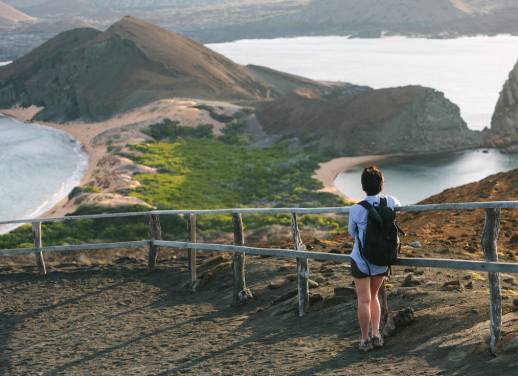‘It feels like I’m not supposed to be here’: my first thought as the Galapagos Islands appeared through the aeroplane window.
It felt as though we were descending into Jurassic Park, or some sacred land that I wasn’t deserving enough to enter. I was glad to be there, don’t get me wrong, but I didn’t feel worthy. This was the Galapagos.
Yeah, that initial glimpse of the islands was humbling. But I’d soon learn that thankfulness is a feeling you’ll experience most days in the Galapagos Islands. With each new wildlife discovery and each new encounter, gratitude is the most common reaction.
And these islands should be admired. They should be understood and prized by as many people as possible. There is nowhere quite like them, certainly not anywhere that I’ve been, and the week I spent there with Intrepid Travel blew my mind in more ways than I thought imaginable.
This diary starts in Baltra, the main airport in the Galapagos Islands, after two heady days in the incredible Quito.
Follow the adventure:
Day 1: Baltra and Santa Cruz Island
Once we cleared customs – which was a fairly rigorous process of form filling, baggage checking, and line waiting – in Baltra we met our leader, Oswaldo Noboa (who’s a naturalist, not a naturist) and boarded a bus bound for the dock. And, presumably, adventure.
Our boat, Nemo III – a beautiful catamaran, originally built in Italy – was waiting on arrival. There’s a Jacuzzi on board that was brought into existence by her original Italian owners, but Galapagos sustainable tourism practices means we can’t use it (it requires hot water, which requires power, which is deemed an unnecessary use). A crying shame on one hand, a win for the planet on the other.
Once on board, we took a short trip to Santa Cruz Island and made a wet landing on Bachus Beach. There, sea lions, marina iguanas, Sally Lightfoot crabs, blue-footed boobies, frigatebirds, pelicans and a sole flamingo were waiting.
The amount of interaction we had on this first day was pretty overwhelming (see feature image). A bunch of fish in the shallows meant that we were lucky enough to witness a boobie, pelican and frigatebird feeding frenzy take place along the beach. It was so impressive that at times you could barely make out the horizon through the rabble. And the horizon is big.
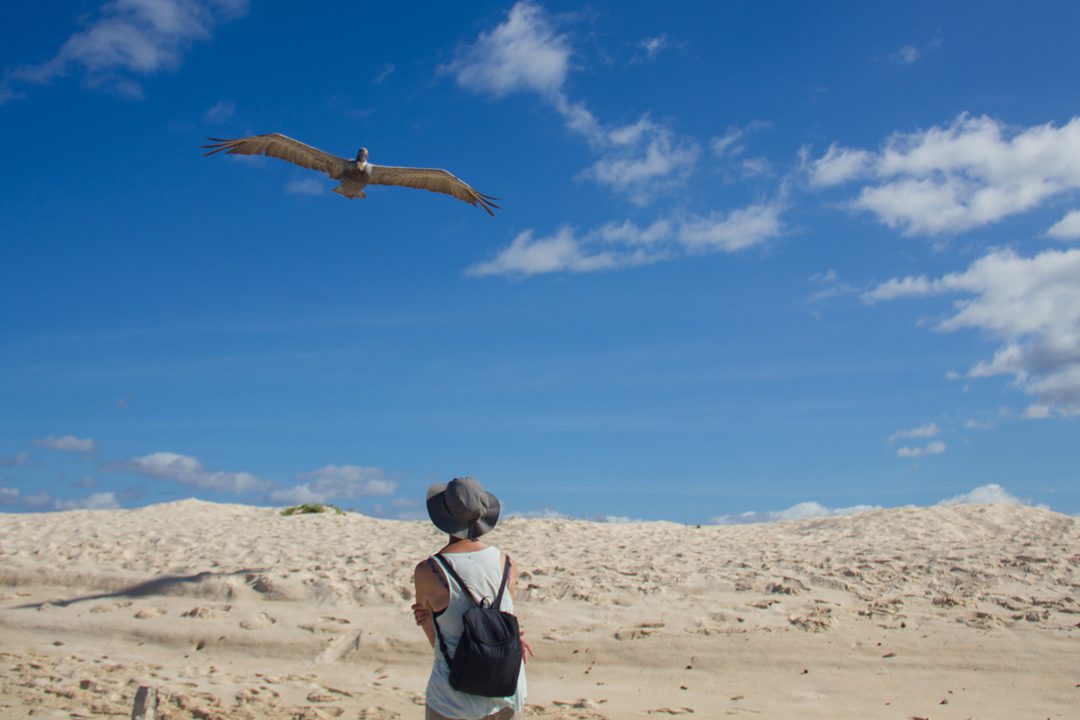
A not-so-rare pelican encounter
We strolled the beach, following the fishing spectacle, and took a thousand photos then swam for a while before reboarding Nemo III.
We met the crew, shared some drinks and swapped stories before settling in for an incredible dinner of camarons (prawns). It’s been am awesome day. But I’m a little jetlagged, a little seasick, a little drunk and have little else to say about it. Tomorrow we will arrive at Genovesa Island, for more bird watching and some snorkelling. Good.
Day 2: Genovesa Island
Sleep was good. It’s completely unsurprising how tiring it is to be walking and snorkelling all day and I can’t even begin to describe how exhaustinge boat life is. Split between eating, drinking and talking, the hours tick by at an alarmingly leisurely pace.
This morning I awoke an hour early for breakfast, because I forgot to set my clock back an hour when I arrived. But what I lost in sleep was more than made up for by watching the sunrise over the prehistoric façade of Genovesa Island. Well, almost.
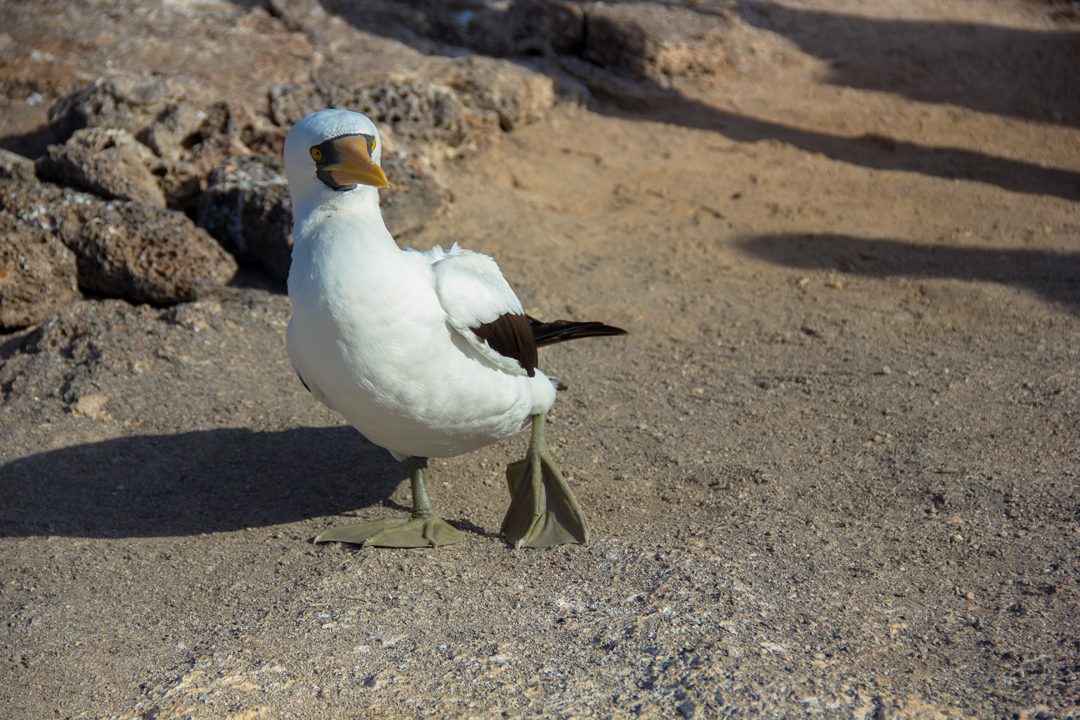
Masked boobies: the goodlooking seagulls of the Galapagos
We took a short boat ride to some steps that ascended the steep cliff and arrived, after climbing said steps, at a clearing, in which masked and red-footed boobies were going about their business as if mankind had never set foot on their turf.
We walked for a short time across the top of Genovesa. The sun baked; we perspired. We saw masked boobies for the first time and I concluded that they were my favourite of all the boobies (except, y’know).
Then we saw red-footed boobies and I reconsidered my conclusion about masked-boobies for a short time, before returning to my original conclusion. They look like big, handsome, clean and thoroughbred seagulls, without any of the annoying sandwich-stealing tendencies.
Related: Fill your own diary. Explore the Galapagos Islands with Intrepid Travel.
We walked to the other side of the Genovesa ‘peninsula’: a rounded semi-cone in the middle of which a volcanic crater once spouted hot stuff. We’re told that masked boobies can’t nest in the trees because they’re too heavy. For a moment I feel sorry for them, but only for a moment.
Once through we reached the clearing we were greeted by a black-on-blue display of Galapagos birds against the sky. Underneath the commotion, the cliff top rolled away and into a sheer drop that none of us, nor any travellers before or after us, would ever see. The thought of a completely unviewed panorama from the northern side of Genovesa Island is as close to perfect as I could imagine. Just as some things are better left unsaid, surely some things are better left unseen.
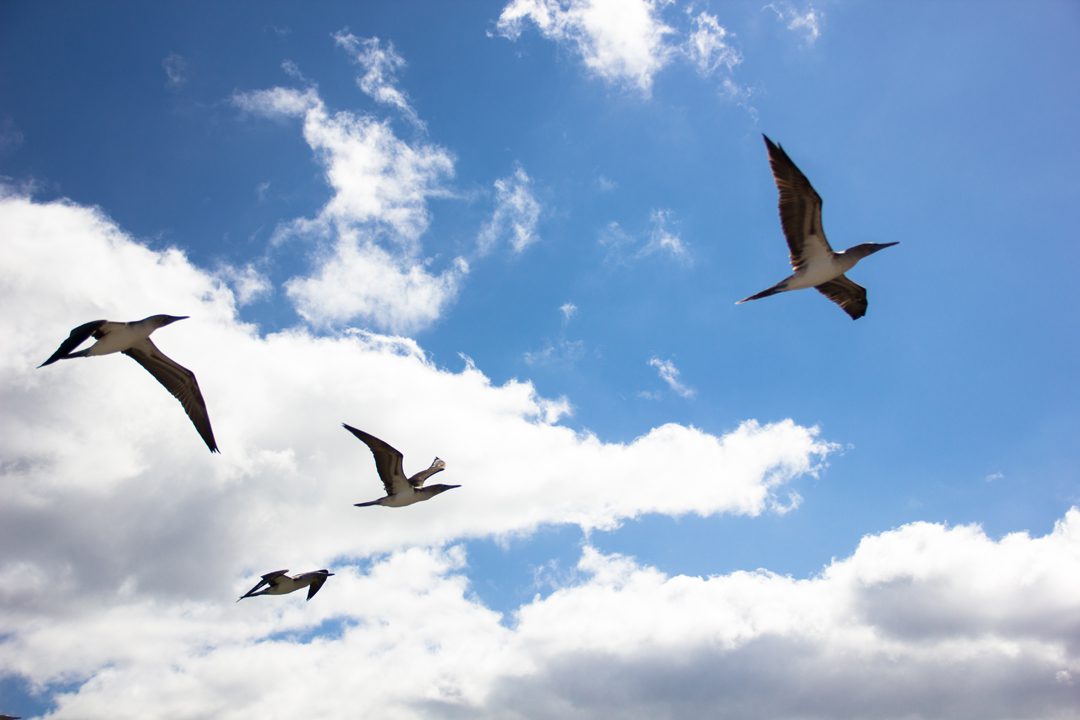
Boobies on Genovesa: not camera shy.
One thing that’s difficult not to be struck by in the Galapagos Islands is how the majority of the wildlife doesn’t so much as flinch when approached by humans. Where seagulls would scatter amongst the sky, boobies sit quietly and watch you pass without giving so much as a second glance.
“I could say the place looked like Mars, or the moon, but that would be cliché and truth be told I have absolutely no idea what either of those places look like.”
After our walk, we returned to Nemo III for lunch after which we climbed aboard the dinghy again and travelled a short distance to a beach, on the opposite side of the crater from our morning excursion.
Here we found sea lions (who are completely adapted to doing bugger all) doing bugger all. We enjoyed another short walk, and saw more red-footed boobies and juvenile frigatebirds.
A small saltwater pool greeted us after 10 or so minutes of walking. In it, a sea lion pup was tossing fish around and playing catch with itself. Imagine if we could teach domestic dogs to play catch with themselves. Imagine.
After we unsuccessfully tried to encourage the sea lions to play with us in the shallows for a while, we headed back to Nemo. We ate and set sail for Sullivans Bay, on Santiago Island.
Day 3: Santiago Island, Sullivans Bay and Dragon’s Hill
We awoke to the serenity of Sullivan’s Bay. Pinnacle Rock was close by, though not many seemed to pay attention to it. Many other islands and chunks of land were visible too. Breakfast was a feast of hot food and fresh fruit, as it seems is the norm aboard Nemo III. We took a boat to shore, which was an enormous lava field.
Lava fields might not sound that interesting or spectacular. I for one, even having read plenty about them, didn’t expect to be affected by them much. But once you begin walking across the field, and you find yourself considering that everything underfoot was once flowing, molten lava, it’s impossible not to feel something. I felt grateful. Grateful to be there, and equally grateful not to be there in 1867, the last time the volcano erupted.
Explore the lava fields on Sullivans Bay by clicking around the below image:
I could say the place looked like Mars, or the moon, but that would be cliché and truth be told I have absolutely no idea what either of those places look like. What it did look exactly like, however, was a field of frozen lava, black, whole; a spectacle completely without time.
Oswaldo told us a story about the human history of the Galapagos Islands. Specifically, it focused on the American occupation during WWII, the Wall of Tears and the Penal colony. It ended with Oswaldo announcing that the two main characters in his story – an eight-year-old boy and a policeman – were his grandfather and his great grandfather. Oswaldo, who moved out here when he was 15-years-old, is tied inextricably to this place.
Snorkelling followed soon after. The water was welcoming after the walk, during which we were sandwiched between the hot lava rock and the hot sun. We were able to play with a sea lion for the first time, which was nothing if not far more novel than playing with a dog.
“We are now bound for I don’t know where, because I haven’t checked the itinerary. But I know that it’s going to be unlike anywhere I’ve been before.”
We snorkelled for one hour and ten minutes. Jack – an Australian from Sydney who’d already been travelling for a few months – and I went ahead to try and spot some sharks before the splashing of the rest of the group scared them off. And it worked. I saw a whitetip reef shark for a few seconds, but by the time I turned around to alert Jack of its presence, it had gone. I’d never swam with sharks before.
A short while after, just as I was considering turning back to the boat because I could feel my neck getting sunburnt, I saw a Galapagos penguin through the water, like a cute torpedo. That penguin was at once the reason I stayed in the water for a further 20 minutes and the reason I have just emptied an entire bottle of aloe vera on my neck.
Play with Galapagos sea lions by clicking around the below image:
As if all of the above wasn’t exhausting enough, Nemo then cruised to Dragon’s Hill, named so after it’s population of land iguanas. As soon as we disembarked the zodiac boat, we spotted marine iguanas in the water, whitetips resting near the shore and sea turtles. The place was a veritable hangout for Galapagos rock stars.
We walked for an hour, maybe more, through the hinterland and up to a small hill, which offered panoramas of aforementioned landscape and its beach and its lagoons. I spotted a big old ship in the distance with its sails up. If I looked just the right way and cut out all the other, more modern boats of my peripheral, I could well have been in the 1600s. I wasn’t, though, and I had a DSLR camera around my neck. So I took it out and took a photo of it. The picture didn’t turn out very well.
Related: Discover the Galapagos Islands with Intrepid Travel
On the way back to the zodiac we came across two land iguanas. They were bright yellow and much larger than their waterborne cousins. Oswaldo thought they were going to have a fight, but they didn’t. So that was that.
Back on board Nemo we jumped straight into the water – we were soaked with sweat and ready to cool our bones. We are now bound for I don’t know where, because I haven’t checked the itinerary. But I know that it’s going to be unlike anywhere I’ve been before.
Day 4: Santa Cruz Island (Puerto Ayora)
Turns out that Puerto Ayora was pretty similar to places I’d been before. It’s the most populated town in the Galapagos and a bit of a tourist hub. We got up early to make tracks to the Charles Darwin Research Centre – the focal point for much of the scientific research that takes place in the Galapagos Islands – and arrived around 7.30am. It was dead quiet. No tourists around at this hour; just the increasing heat and the imposing stench of giant tortoise poo.
We didn’t get to see any of the labs, which was a bit of a shame, but we did see young giant tortoises, the smallest of which were no longer than four or five inches, so they just looked like regular tortoises. The adult ones didn’t even look real.
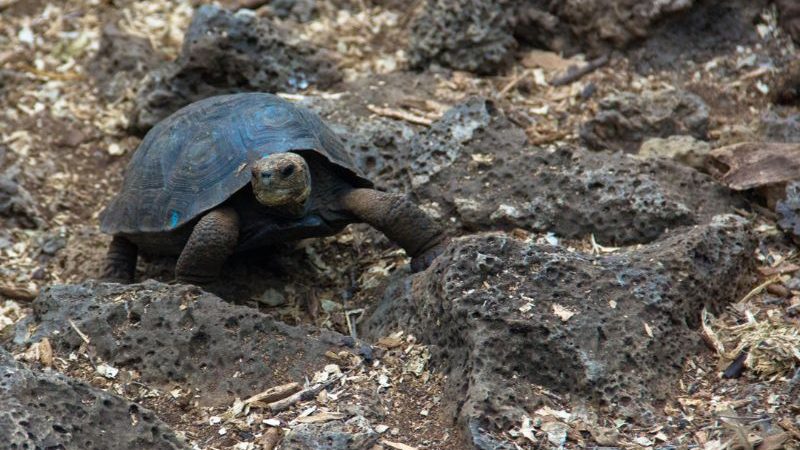
A non-giant giant tortoise
We saw the pen in which Lonesome George, the last Pinta giant tortoise lived before he passed away in 2012. The guide then went on to tell us how Lonesome George didn’t want to reproduce with either of the two females who were not-so-subtly placed in his pen.
George’s disinterest in these shell-clad damsels would eventually lead to the extinction of his subspecies. Earlier in the tour, our guide had explained how scientists are able to choose the sex of the tortoises they breed – 28 degrees and you get a male, 29 degrees and you get a female. Guido, an Italian on our trip who had a knack for saying the wrong thing at the right time, pointed to a picture of Lonesome George and said:
“30 degrees: gay.”
Thanks to Guido, I spent the rest of the tour pondering whether or not the scientists had done much research into homosexuality in giant tortoises. They must have, I thought, because the rest of their research into why Lonesome George didn’t want to reproduce had been inconclusive. And if George wasn’t gay, maybe the pressure was just too much for the poor chap.
Later, we travelled into the highlands and saw some giant tortoises in the wild. I much preferred this to seeing them shut up in pens. I mean; I know the Charles Darwin Research Centre is essential for breeding, research and other scientific stuff, but seeing these not-so-wild beasts in their natural habitat was a real thrill. And I use ‘thrill’ in the tamest imaginable sense of the word.
In the afternoon we spent free time in the town. Free time consisted of a couple of beers in a colourful bar whilst watching local kids skateboard and play volleyball. It was at this point I noticed that whenever I sat down I felt a strange, side-to-side rocking sensation, as if I was still at sea. The beers didn’t help, either.
Day 5: Isabela Island (Urvina Bay)
Today started with I can’t remember what because today is actually the day after today. I neglected to write yesterday, so I’m trying, with some difficulty, to recollect what we awoke to. I believe it was something like: big hunk of land, lava formations, volcano, ocean, birds – in no particular order. All that may not sound too impressive, but I can assure you that it was. I think.
After the bit I can’t remember, we took the zodiac to shore and proceeded to walk across some more old lava formations on Isabela Island. This lava was far rougher and older-looking than the stuff we’d seen before. Oswaldo told us a story about a young American student who walked off the track six years ago and fell 20 metres to his death. The most striking part of the story was that his girlfriend, who was travelling with him, didn’t even notice he was missing until dinner that night. After the story, we saw some flamingos and sweated a little. It was hot.
“For most places in the world, the clichés will usually do. But there are no ‘beautiful vistas’, ‘awe-inspiring panoramas’, or ‘serene landscapes’ in the Galapagos Islands”
After the sweating, we took a short detour en-route back to Nemo and saw a host of animals that had colonised some rocks. You could’ve fit sea lions, marine iguanas, sea turtles, blue-footed boobies, Galapagos penguins and pelicans all into the same photo. I say ‘you could’ve’ because I didn’t, but I’m sure someone else has at some other juncture.
The afternoon went something like: snorkelling with sea turtles (which was by far and away one of the most incredible experiences I’ve ever had), spotting a seahorse whilst snorkelling, visiting a black sand beach, snorkelling with Galapagos penguins off the black sand beach, taking a short stroll back from the beach and encountering land iguanas and giant tortoise, sampling some home made grappa from the four Hungarians who recently joined Nemo III, bed.
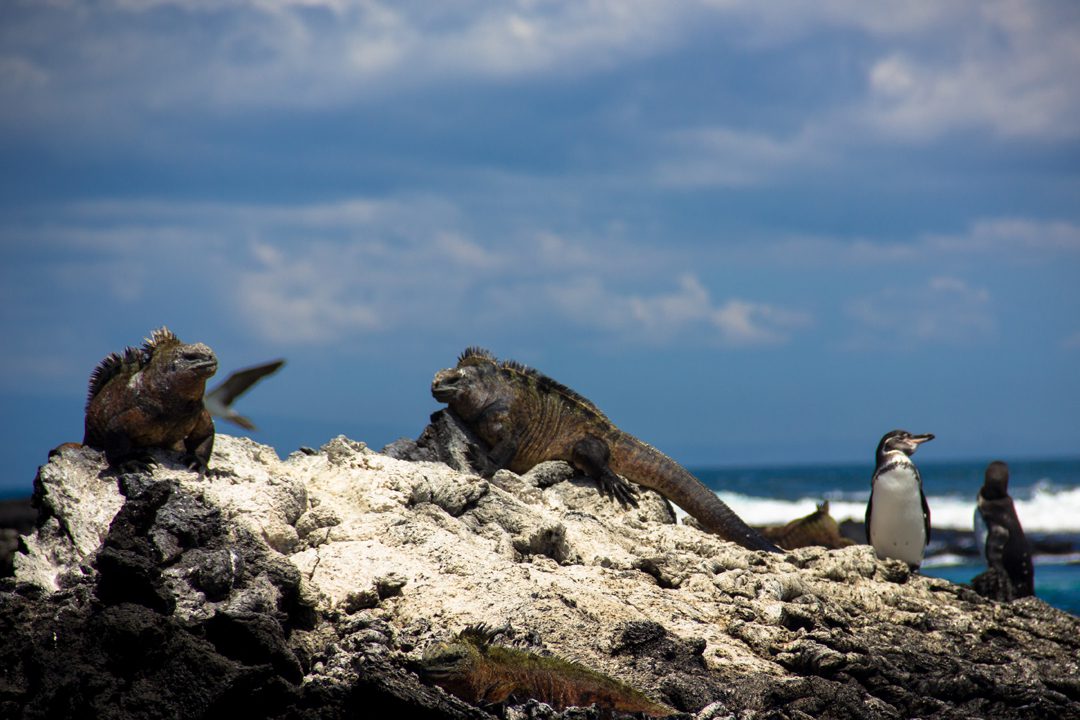
In the immortal words of the Spice Girls: “Iguana be my lover, you better get with my friend. My friend is a penguin.”
I keep trying to think of words and phrases to describe what I’m seeing here but I can’t. For most places in the world, the clichés will usually do. But there are no ‘beautiful vistas’, ‘awe-inspiring panoramas’, or ‘serene landscapes’ in the Galapagos Islands. It’s all so much more than that. Anything less than what’s required would be an insult to Isla Galapagos, so please bear with me whilst I try and figure out what I’m trying to say.
Day 6: Fernandina and Isabela
I felt exhausted when I woke up today. The Hungarian’s generosity with their grappa may have had something to do with it. I don’t even know what grappa is, or if that’s how you spell it, but it was pretty tasty for a home made-drop. And I’m not blind, so that’s good.
The zodiac took us to the shore or Fernandina around 8am. The sky was grey, which was good – the sun here burns quicker than any sun I’ve ever met. We walked across more lava rock, interspersed with beach and mangroves, and saw the biggest mob (we don’t know the collective noun for them) of marine iguanas we’ve seen yet. The place also stunk. Apparently that’s what happens when you leave a bunch of marine iguanas and sea lions to laze around in the searing heat all day and get a bunch of birds to poop all over them. Who knew?
The best part, for me at least, of being on Fernandina was that we saw an Orca from the shore. We didn’t see much, just a few glimpses of the dorsal fin in the far distance, but it was still one of the greatest things I’ve ever witnessed. Pure power.
“…our debarkation would likely be busy. Or busy at least for Galapagos, which is defined by having around 40-50 people within your peripheral vision at any one time.”
After fresh juice (blackberry, I think) on Nemo we went snorkelling again. And again, we were blessed by the presence of sea turtles. Sea turtles are a lot like cows, with shells, that live underwater and don’t look like cows. They just kind of float around and graze on algae. If a cow ever found itself in water, I would imagine that after several thousand years it would eventually evolve into a sea turtle. And vice versa, if a sea turtle were to ever find itself on land. Ridiculous, maybe, but also maybe not.
We arrived at Darwin Bay after leaving the Fernandina and climbed some raggedy old steps, then a dirt path, up to a view of Darwin’s Lake – a lake that formed in an old volcanic crater. Apparently Darwin came here in search of water in 1835 and so they named the lake after him. Seems a bit over the top if you ask me.
The lake was nice, though, and Don (an older Australian gent) was glad to have made it up there. I could tell Don was glad to have made it up there because he asked Dane (a younger Australian gent) to take his photo at the top, which is usually a good indicator of someone being pretty pleased to have done something.
After the walk we were all hot so most people went swimming around Nemo, except my friend Hunter and I, who chatted with Oswaldo. He’s an interesting guy, and extremely passionate about the Galapagos, wildlife and conservation. It was good talking to him.
Now, we have a long navigation to our next port of call, Santiago Island. It’s 5.25pm and we expect to arrive around 5am. In about an hour and a half we will cross the equator (and have dinner). The beers taste good tonight.
Day 6: Santiago Island (James Port and Espumilla Beach)
There were about three or four boats anchored near us when we awoke this morning. This meant that our debarkation would likely be busy. Or busy at least for Galapagos, which is defined by having around 40-50 people within your peripheral vision at any one time.
We took the zodiac over to the shore – another one made of black sand – and were the last group to arrive. We were supposed to set off on a walk to find fur sea lions before snorkelling from the beach, but as the other groups had already started the walk, Oswaldo suggested we do snorkelling first.
Swim with the fishes by clicking around the below image:
It was a good suggestion – we had the entire beach to ourselves. We snorkelled among whitetip reef sharks and it was the best showing of them we’d seen so far. At one point, I looked down to find two swimming in circles no more than four feet underneath me. Mental.
I swam back to the beach to join the others and begin our walk, but I was distracted en-route by a sea lion that seemed game for a bit of rough and tumble. It shot forward and danced and dived up and under, blew bubbles, barrel rolled and generally made a spectacle of itself. It was an effort to keep up with the thing, and probably one of the best experiences I had on the trip.
Related: Peruse Intrepid’s Galapagos Island itineraries
The walk was similar to other Galapagos walks we’d had. Sparse landscapes fringed with wild oceans, overseen by anxious black clouds, iguanas laying all over the place, the click of camera shutters never too far away. We found the fur sea lions, which looked a lot like regular sea lions, before heading back to the beach and joining our crew from Nemo III for a quick game of football on top of a little lookout. It was a blast, until Jack popped a blood vessel in his leg and we had to cut it short. He’s a nurse, though, so he’s in good hands.
After lunch we snorkelled off the dinghy at Espumilla Beach. White-tips, a solitary sea turtle and a load of fish were in there (the ocean) to greet us. We’re now bound, with the sails up, for I don’t know where (again). It’s our last night on Nemo III tonight, which is sad. It’s been an unbelievable week.
Day 7: Daphne, Baltra and Quito
Nothing much planned for the day, except the overwhelmingly sad journey back to normality. We awoke at dawn to watch, um, dawn, and do a couple of laps of Daphne Island before heading back to Baltra, then Quito, then home.
We left the crew and Oswaldo our tips, shook hands and said our sad goodbyes. Sometimes the end of a trip sees many folks glad to be heading home, but it didn’t feel like that today.
Some of our group went off to other islands to carry on their Galapagos explorations, some headed to Guayaquil and others onwards to Quito. I fell into the latter category and by the time we got back to the mainly our numbers were seriously depleted. Again, the sadness!
I sprawled out on my hotel bed and opened my laptop to flick through the thousands of photos I took whilst I was away, desperate to hang on to the trip for as long as I could.
And as I did so, I again felt a very real sense of gratitude wash over me. The Galapagos Islands are surreal. And as I write this, the last entry of a weeks’ worth, I find it difficult to comprehend just how unbelievable the past few days have been.

